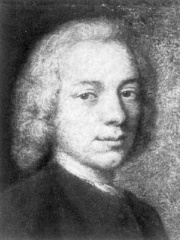MATHEMATICIAN
Jordanus de Nemore

 Jordanus de Nemore
Jordanus de Nemore
Jordanus de Nemore (fl. 13th century), also known as Jordanus Nemorarius and Giordano of Nemi, was a thirteenth-century European mathematician and scientist. The literal translation of Jordanus de Nemore (Giordano of Nemi) would indicate that he was an Italian. He wrote treatises on at least 6 different important mathematical subjects: the science of weights; “algorismi” treatises on practical arithmetic; pure arithmetic; algebra; geometry; and stereographic projection. Read more on Wikipedia
His biography is available in 16 different languages on Wikipedia (up from 15 in 2024). Jordanus de Nemore is the 541st most popular mathematician (up from 745th in 2024), the 3,317th most popular biography from Germany (up from 4,621st in 2019) and the 64th most popular German Mathematician.
Memorability Metrics
Page views of Jordanus de Nemore by language
Among MATHEMATICIANS
Among mathematicians, Jordanus de Nemore ranks 541 out of 1,004. Before him are Rózsa Péter, Pietro Mengoli, Hans Freudenthal, Erik Ivar Fredholm, Max Dehn, and Joseph Ludwig Raabe. After him are Jean Leray, Terence Tao, Theodosius of Bithynia, Adam Ries, Andrew M. Gleason, and Ibrahim ibn Sinan.
Most Popular Mathematicians in Wikipedia
Go to all RankingsRózsa Péter
1905 - 1977
HPI: 60.06
Rank: 535
Pietro Mengoli
1626 - 1686
HPI: 60.05
Rank: 536
Hans Freudenthal
1905 - 1990
HPI: 60.04
Rank: 537
Erik Ivar Fredholm
1866 - 1927
HPI: 60.02
Rank: 538
Max Dehn
1878 - 1952
HPI: 60.01
Rank: 539
Joseph Ludwig Raabe
1801 - 1859
HPI: 60.00
Rank: 540
Jordanus de Nemore
HPI: 59.94
Rank: 541
Jean Leray
1906 - 1998
HPI: 59.94
Rank: 542
Terence Tao
1975 - Present
HPI: 59.92
Rank: 543
Theodosius of Bithynia
160 BC - 100 BC
HPI: 59.91
Rank: 544
Adam Ries
1492 - 1559
HPI: 59.82
Rank: 545
Andrew M. Gleason
1921 - 2008
HPI: 59.81
Rank: 546
Ibrahim ibn Sinan
908 - 946
HPI: 59.81
Rank: 547
In Germany
Among people born in Germany, Jordanus de Nemore ranks 3,319 out of 7,253. Before him are Ludwig Kaas (1881), Eberhard I, Count of Württemberg (1265), Rolf Carls (1885), Charles II, Margrave of Baden-Durlach (1529), Prince Friedrich Leopold of Prussia (1865), and Duchess Maria Anna Josepha of Bavaria (1734). After him are Karl, Duke of Schleswig-Holstein-Sonderburg-Glücksburg (1813), Hans Rottenhammer (1564), Hansi Müller (1957), Barthel Beham (1502), Princess Therese of Bavaria (1850), and John Ernest I, Duke of Saxe-Weimar (1594).
Others born in Germany
Go to all RankingsLudwig Kaas
RELIGIOUS FIGURE
1881 - 1952
HPI: 59.95
Rank: 3,313
Eberhard I, Count of Württemberg
POLITICIAN
1265 - 1325
HPI: 59.95
Rank: 3,314
Rolf Carls
MILITARY PERSONNEL
1885 - 1945
HPI: 59.95
Rank: 3,315
Charles II, Margrave of Baden-Durlach
POLITICIAN
1529 - 1577
HPI: 59.95
Rank: 3,316
Prince Friedrich Leopold of Prussia
POLITICIAN
1865 - 1931
HPI: 59.95
Rank: 3,317
Duchess Maria Anna Josepha of Bavaria
POLITICIAN
1734 - 1776
HPI: 59.95
Rank: 3,318
Jordanus de Nemore
MATHEMATICIAN
HPI: 59.94
Rank: 3,319
Karl, Duke of Schleswig-Holstein-Sonderburg-Glücksburg
POLITICIAN
1813 - 1878
HPI: 59.94
Rank: 3,320
Hans Rottenhammer
PAINTER
1564 - 1625
HPI: 59.94
Rank: 3,321
Hansi Müller
SOCCER PLAYER
1957 - Present
HPI: 59.93
Rank: 3,322
Barthel Beham
PAINTER
1502 - 1540
HPI: 59.93
Rank: 3,323
Princess Therese of Bavaria
BIOLOGIST
1850 - 1925
HPI: 59.93
Rank: 3,324
John Ernest I, Duke of Saxe-Weimar
NOBLEMAN
1594 - 1626
HPI: 59.92
Rank: 3,325
Among MATHEMATICIANS In Germany
Among mathematicians born in Germany, Jordanus de Nemore ranks 64. Before him are Otto Hölder (1859), Friedrich Hirzebruch (1927), Friedrich Robert Helmert (1843), Henryk Zygalski (1908), Hans Freudenthal (1905), and Max Dehn (1878). After him are Adam Ries (1492), Abraham Gotthelf Kästner (1719), Johann Samuel König (1712), Max August Zorn (1906), Wilhelm Jordan (1842), and Max Noether (1921).
Otto Hölder
1859 - 1937
HPI: 60.74
Rank: 58
Friedrich Hirzebruch
1927 - 2012
HPI: 60.66
Rank: 59
Friedrich Robert Helmert
1843 - 1917
HPI: 60.62
Rank: 60
Henryk Zygalski
1908 - 1978
HPI: 60.50
Rank: 61
Hans Freudenthal
1905 - 1990
HPI: 60.04
Rank: 62
Max Dehn
1878 - 1952
HPI: 60.01
Rank: 63
Jordanus de Nemore
HPI: 59.94
Rank: 64
Adam Ries
1492 - 1559
HPI: 59.82
Rank: 65
Abraham Gotthelf Kästner
1719 - 1800
HPI: 59.69
Rank: 66
Johann Samuel König
1712 - 1757
HPI: 59.69
Rank: 67
Max August Zorn
1906 - 1993
HPI: 59.35
Rank: 68
Wilhelm Jordan
1842 - 1899
HPI: 59.33
Rank: 69
Max Noether
1921 - 1921
HPI: 59.23
Rank: 70

































